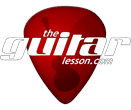If you want to improve your guitar skills, it's crucial to have a firm grasp of the fretboard. But let's be honest, it seems like a big mess of notes at first.
Enter the CAGED system, which will help you make sense of the guitar fretboard in no time.
What is the CAGED system?
The CAGED system is a method for guitar players to learn the fretboard and visualize chord shapes and scale patterns. The name comes from the five basic open-position chord shapes used to play any major or minor key: C, A, G, E, and D.
The CAGED system is a valuable tool for both beginner and advanced guitarists since you can use it to:
- Play any scale or chord in any key.
- Help guitarists learn new chord voicings and scale patterns.
- Transpose songs into different keys.
- Create new melodies and improvisations.
Understanding the CAGED system on the guitar can help you see the fretboard as a series of interconnected shapes and patterns rather than a mass of unrelated notes.
Here is a brief explainer video, but make sure to read the rest of the article as well.
What are the chords in CAGED?
If you ever see the CAGED system mentioned anywhere, they'll be speaking of the 5 basic chord shapes.
The individual letters in the word CAGED refer to these chords:
C, A, G, E, D
This is the natural order of the chord shapes going up the fretboard, as you'll see on the diagram below (using C as the root note marked by the darker dot):
Now let's look at the 5 chord shapes of the CAGED system in detail.
C shape
This is what the open C major chord shape looks like. It is a basic beginner chord that you will undoubtedly know already. Flet's form the chord, noticing where your fingers go.
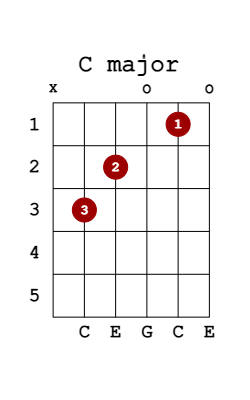
Now if you use your index finger to barre the nut and move the chord up 2 semitones, you would get a D major chord in tonality, using the C shape from CAGED.
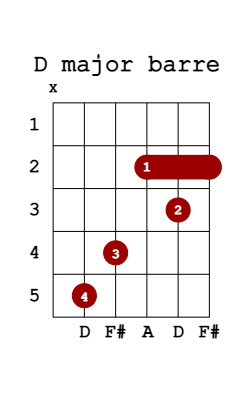
A shape
This is what the open A major chord shape looks like. You should be familiar with this one as well. There are a number of ways to finger this chord, this is my preferred one.
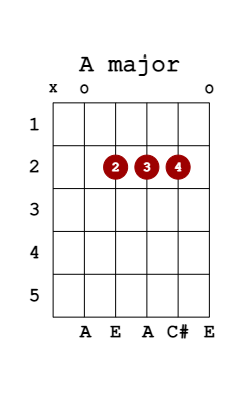
Just like with the C chord example above, if you move this entire shape up 2 frets and use your index finger to replace the nut, you will get a B major chord using the CAGED A major barre shape.
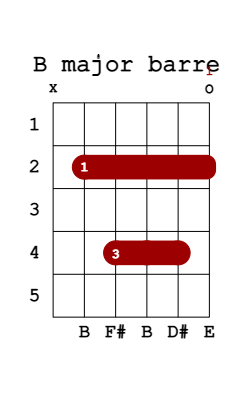
G shape
You should be familiar with the G major chord as well. This one is a bigger chord, so your fingers will be further apart. This is my preferred fingering, but you may use something else.
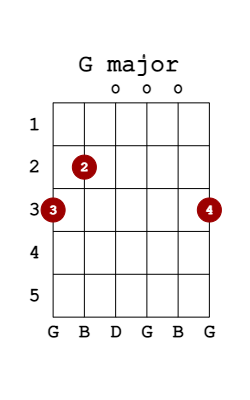
If you move this shape up the fretboard by 2 semitones, you will get an A major chord. As you can see, the G shape barre is difficult, but I'll talk about overcoming this later.
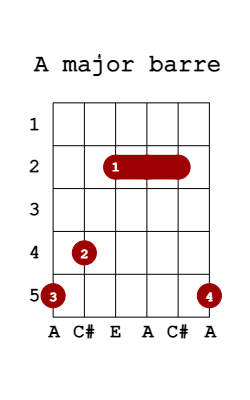
E shape
The E major chord is a favorite of most beginner students, since it is so easy to play. It is one of the first chords you probably learned as a beginner guitar player.
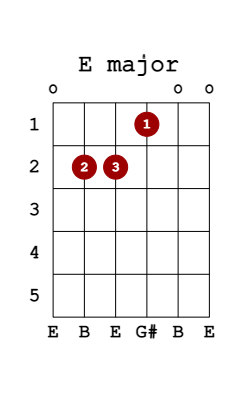
Now we'll only move this chord shape up 1 semitone, to arrive at the "dreaded" F major barre chord. Notice how you are forming the E major shape, adding your finger in place of the nut.
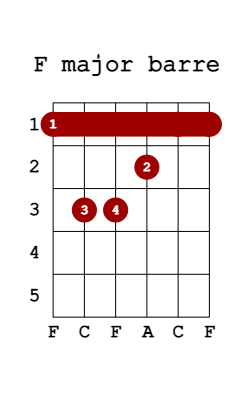
D shape
The D major chord shape is the final chord shape in the CAGED system. Again, the D major is a beginner chord that you learned at the beginning of your guitar journey.
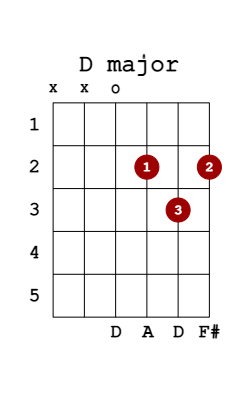
Moving the entire shape up by 2 semitones, you'll arrive at an E major chord. You don't need to form a barre here, but it is still a difficult fingering that I will simplify later in the article.
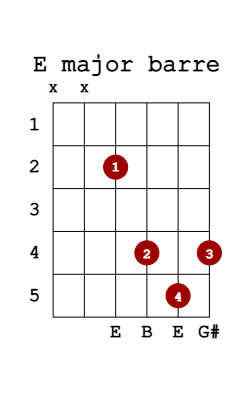
These are the chord shapes used in the CAGED system. In review:
- You take your basic C, A, G, E, D chords
- Create movable chords out of them by altering your fingering somewhat, so that the initial open strings are held down.
- Now move the shape anywhere on the fretboard, and you get a valid chord X intervals away in tonality from the original open chord.
As you can see, some barre chords are easier than others. The "G" shape barre chord and the "D" shape barre chord can be a little awkward to play. I alter them a bit to make them more comfortable and create a slightly different sound, but more on that later.
What is the CAGED system used for in practice?
OK, this is all nice, but how can you actually use CAGED as a guitar player?
There are a number of ways, as you'll see below.
Connecting the CAGED system shapes
Taking this concept of moveable chord shapes and applying it to a single chord is the full usefulness of the CAGED system.
The system maps out the fretboard in a logical way, because you can play any given chord all over the neck using the CAGED forms. Each shape connects to the previous.
- C connects to A form
- A connects to G form
- G connects to E form
- E connects to D form
- D connects to C form, and the pattern repeats itself from here
Finding new guitar chord voicings via CAGED
By learning 5 chord shapes, you instantly know 5 voicings to any chord. Now you can use the new voicings, or just partial chords to vary things up and make your music more interesting.
For example, if you're bored of playing E Major in the first position, why not find the root note on the fifth string and use an "A" shape barre chord?

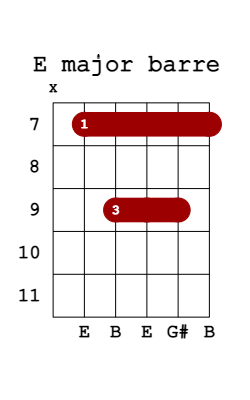
Or you can even take it a step further and use the top 3 strings as an inverted chord.
Just leave the lowest strings out of the chords, and modify your fingering to make it as comfortable as possible like so.
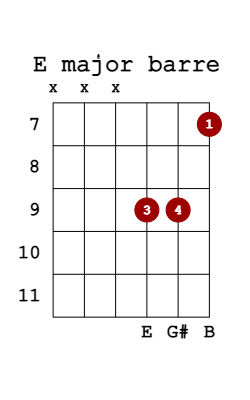
The same goes for every other chord as well. Just find the root note, and apply any shape. Each of the twelve major guitar chords can be played in their own position along the neck, using one of these five chord shapes.
The diagram below has the root D (root notes are the black dots), so the graph shows all D major chord voicings across the fretboard!
But if you were to move everything over to the right by 2 frets, you would have the D note as your root, so you now have all voicings of the D major chord (The darker dots mark the D root).
Use CAGED to transpose songs
You can use CAGED to transpose songs.
You first identify the song's key, find the corresponding CAGED chord shapes, and simply move everything up or down on the fretboard.
Tips on how to learn the CAGED system (with exercises)
If you want to unlock the fretboard once and for all, the CAGED system is a great way to go. Here are some specific exercises that will help you make CAGED, and thereby the fretboard, your own.
Learn the root notes of each shape
It is essential that you learn the root notes for each position once you know the CAGED chord shapes.
The C, A, and D shapes have 2 root notes, the E and G shape have 3 root notes. These anchor points help you quickly find the chords across the neck, if you learn to connect the shapes via their root notes.
Get to know the barre chord shapes
In this basic CAGED system exercise, you need to play a C major chord using each barre shape from CAGED, moving higher and higher up the neck.

-guitar-chord-xx0305050503-x13331-eadgbe-major-0.png)
-guitar-chord-080705050508-321114-eadgbe-major-0.png)
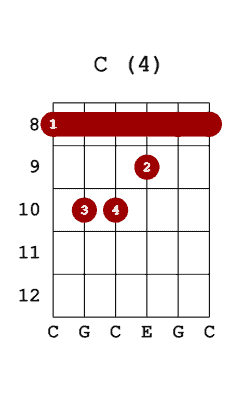
-guitar-chord-xxxx10121312-xx1243-eadgbe-major-0.png)
Please focus on the root note locations and how they are interconnected between each shape as visualized on this chart.

Once you reach the top chord and can't go any further, go back down the fretboard using the CAGED shapes in reverse this time.
Now form your standard A major chord, and using CAGED, play it in all shapes as you did with C major.
Do the same for the G major, A major, and D major.
Repeat this several times, every day for a week, and you should be good to go.
Sometimes less is more
If you remember from chord theory, you only need 3 notes to play a major chord.
Thank GOD! I'm sure you noticed that the G and D barre chord shapes are a bit awkward.
You don't need to play the entire chord shape:
The root, 3rd, and 5th are enough for a major chord.
You can find tons of chord inversions like this, where the root note is not the lowest note of your chord.
For example, here is the diagram of the C major using the G-shaped barre chord. It is impossible to play
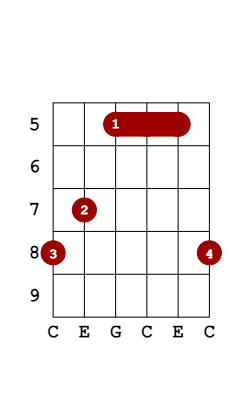
But if you leave a few notes out, you can still use this G shape from CAGED to play the chord.
Remember, it is a proper major chord as long as you are using the root, 3rd, and 5th-degree notes of a chord. Here are 2 examples.
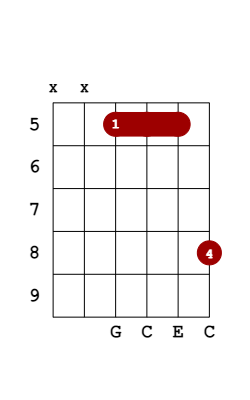
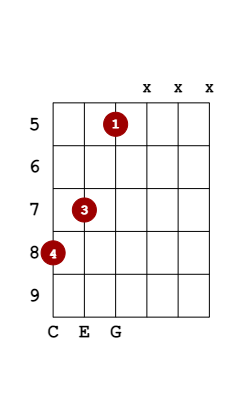
Now play the C major using the D shape from CAGED, without using the note from the D string.
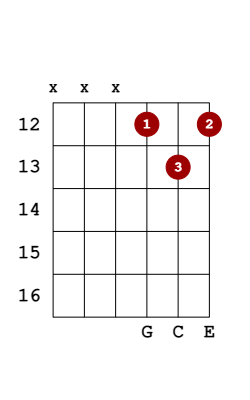
This is a very popular inversion of any chord played using this 3-note D shape, and it is very easy to play anywhere on the fretboard.
Experiment with minor chords in CAGED
You can't play some minor chords fully in the CAGED system because of impossible fingerings, which means you will need to use chord inversions in these cases.
It is impossible to play the full Cm, Gm, and D minor shapes as movable chords. (Please leave a comment if you want me to make chord charts on these as well).
But as you've learned, you only need the root, minor 3rd, and 5th degree notes to play a minor chord.
Like with the previous CAGED exercise, find suitable inversions for minor chords.
7th chords and other alterations
You should see how you can play any chord on the CAGED system by modifying the base open chord shape and moving it up the neck.
As we saw with the minor chord, you will not be able to play each note of every chord, but that is OK.
You can use chord inversions to play chords anywhere on the neck; just make sure you are using notes characteristic of your chord.
Find alternate chord voicings for your favorite songs
One way to find alternate guitar chord voicings for your favorite songs is to use the CAGED system:
- First identify the notes in the scale the song uses.
- Then, find the chords played in the song in its respective key. For example, if you are using a G major scale, the notes in the scale are G, A, B, C, D, E, and F#.
- By finding all of the possible chord voicings for each shape, you will be able to find many different ways to play your favorite songs.
Conclusion
The CAGED system is an excellent way for guitarists to learn the fretboard and understand how chords are related.
It can help you see patterns and shapes that you wouldn't otherwise notice, making it an invaluable tool for learning new songs or improving your improvisational skills.
Whether you're a beginner or a seasoned player, the CAGED system is worth checking out!
